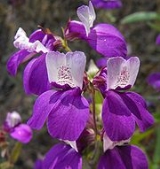
Collinsia heterophylla
Encyclopedia
Collinsia heterophylla (syn. C. bicolor) is a flowering plant
native to California
and Baja California
. It is known as Purple Chinese Houses or Innocence. Like the other species in the genus
Collinsia, which also includes the Blue-eyed Marys, it gets its name from its towers of inflorescence
s, of decreasing diameter, which give the plants in full flower a certain resemblance to a pagoda
.
Purple Chinese Houses is an annual plant
growing in shady places, and can be found in most of California, other than desert regions, below about 1000 metres (3,280.8 ft). It blooms from mid spring to early summer. The plant is 10–50 cm (3.9–19.7 ) tall.
Dried in air, the seeds weigh about 1 mg each.
The species was first described as Collinsia bicolor by George Bentham
in 1835, but this name proved to be a later homonym of Collinsia bicolor Raf.
(described in 1824) necessitating the name change to C. heterophylla. Despite this, the name C. bicolor is still sometimes used for this species.
Flowering plant
The flowering plants , also known as Angiospermae or Magnoliophyta, are the most diverse group of land plants. Angiosperms are seed-producing plants like the gymnosperms and can be distinguished from the gymnosperms by a series of synapomorphies...
native to California
California
California is a state located on the West Coast of the United States. It is by far the most populous U.S. state, and the third-largest by land area...
and Baja California
Baja California
Baja California officially Estado Libre y Soberano de Baja California is one of the 31 states which, with the Federal District, comprise the 32 Federal Entities of Mexico. It is both the northernmost and westernmost state of Mexico. Before becoming a state in 1953, the area was known as the North...
. It is known as Purple Chinese Houses or Innocence. Like the other species in the genus
Genus
In biology, a genus is a low-level taxonomic rank used in the biological classification of living and fossil organisms, which is an example of definition by genus and differentia...
Collinsia, which also includes the Blue-eyed Marys, it gets its name from its towers of inflorescence
Inflorescence
An inflorescence is a group or cluster of flowers arranged on a stem that is composed of a main branch or a complicated arrangement of branches. Strictly, it is the part of the shoot of seed plants where flowers are formed and which is accordingly modified...
s, of decreasing diameter, which give the plants in full flower a certain resemblance to a pagoda
Pagoda
A pagoda is the general term in the English language for a tiered tower with multiple eaves common in Nepal, India, China, Japan, Korea, Vietnam and other parts of Asia. Some pagodas are used as Taoist houses of worship. Most pagodas were built to have a religious function, most commonly Buddhist,...
.
Purple Chinese Houses is an annual plant
Annual plant
An annual plant is a plant that usually germinates, flowers, and dies in a year or season. True annuals will only live longer than a year if they are prevented from setting seed...
growing in shady places, and can be found in most of California, other than desert regions, below about 1000 metres (3,280.8 ft). It blooms from mid spring to early summer. The plant is 10–50 cm (3.9–19.7 ) tall.
Dried in air, the seeds weigh about 1 mg each.
The species was first described as Collinsia bicolor by George Bentham
George Bentham
George Bentham CMG FRS was an English botanist, characterized by Duane Isely as "the premier systematic botanist of the nineteenth century".- Formative years :...
in 1835, but this name proved to be a later homonym of Collinsia bicolor Raf.
Constantine Samuel Rafinesque-Schmaltz
Constantine Samuel Rafinesque-Schmaltz, as he is known in Europe, was a nineteenth-century polymath who made notable contributions to botany, zoology, the study of prehistoric earthworks in North America and Mesoamerican ancient linguistics.Rafinesque was eccentric, and is often portrayed as an...
(described in 1824) necessitating the name change to C. heterophylla. Despite this, the name C. bicolor is still sometimes used for this species.
External links
- Species treatment from the Jepson Manual
- http://elib.cs.berkeley.edu/cgi/img_query?where-lifeform=any&rel-taxon=contains&where-taxon=Collinsia+heterophylla&rel-namesoup=contains&where-namesoup=&rel-location=like&where-location=&rel-county=eq&where-county=any&rel-state=eq&where-state=any&rel-country=eq&where-country=any&where-collectn=any&rel-photographer=eq&where-photographer=any&rel-kwid=equals&where-kwid=Photographs from the CalPhotos archive]

